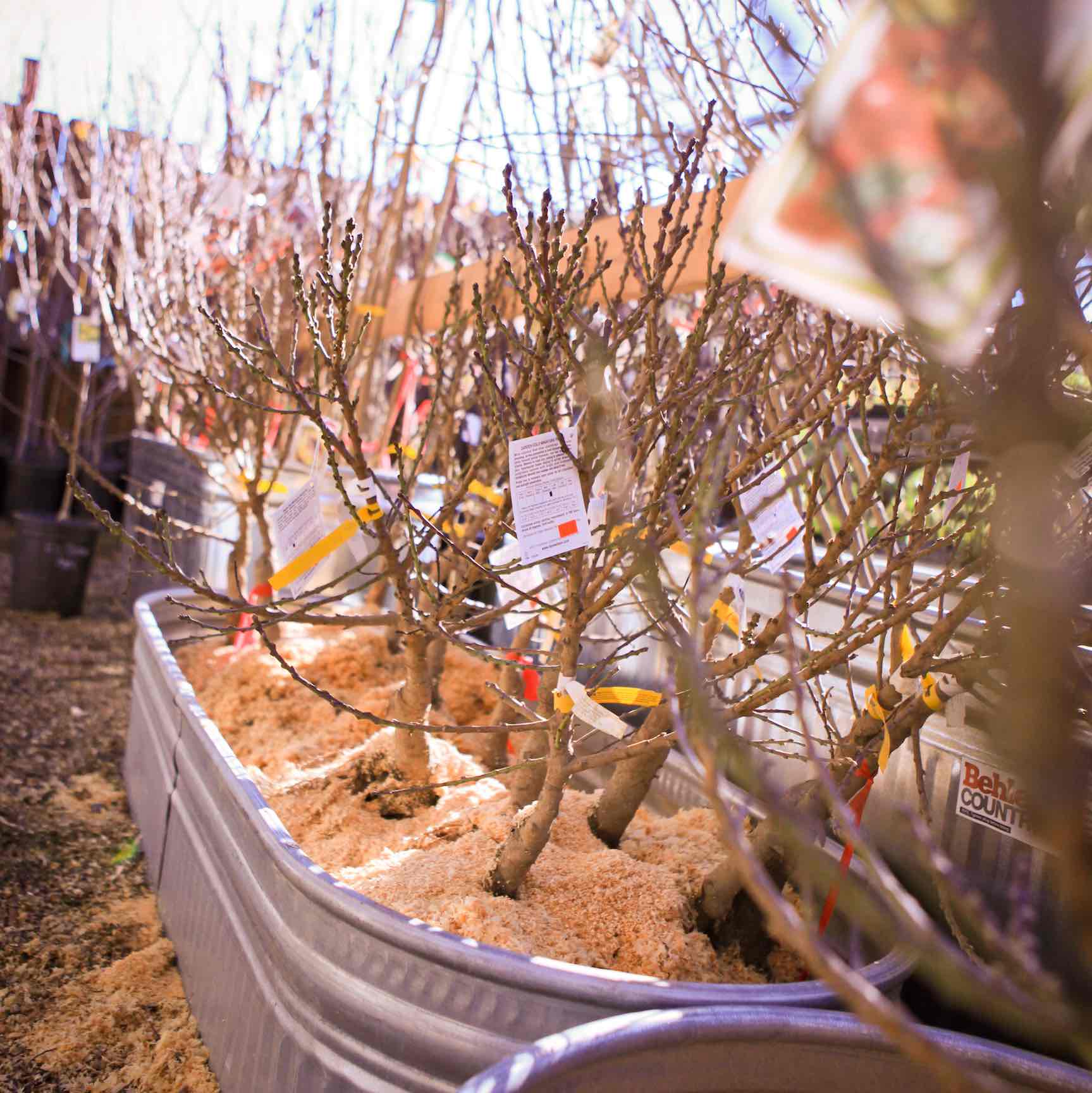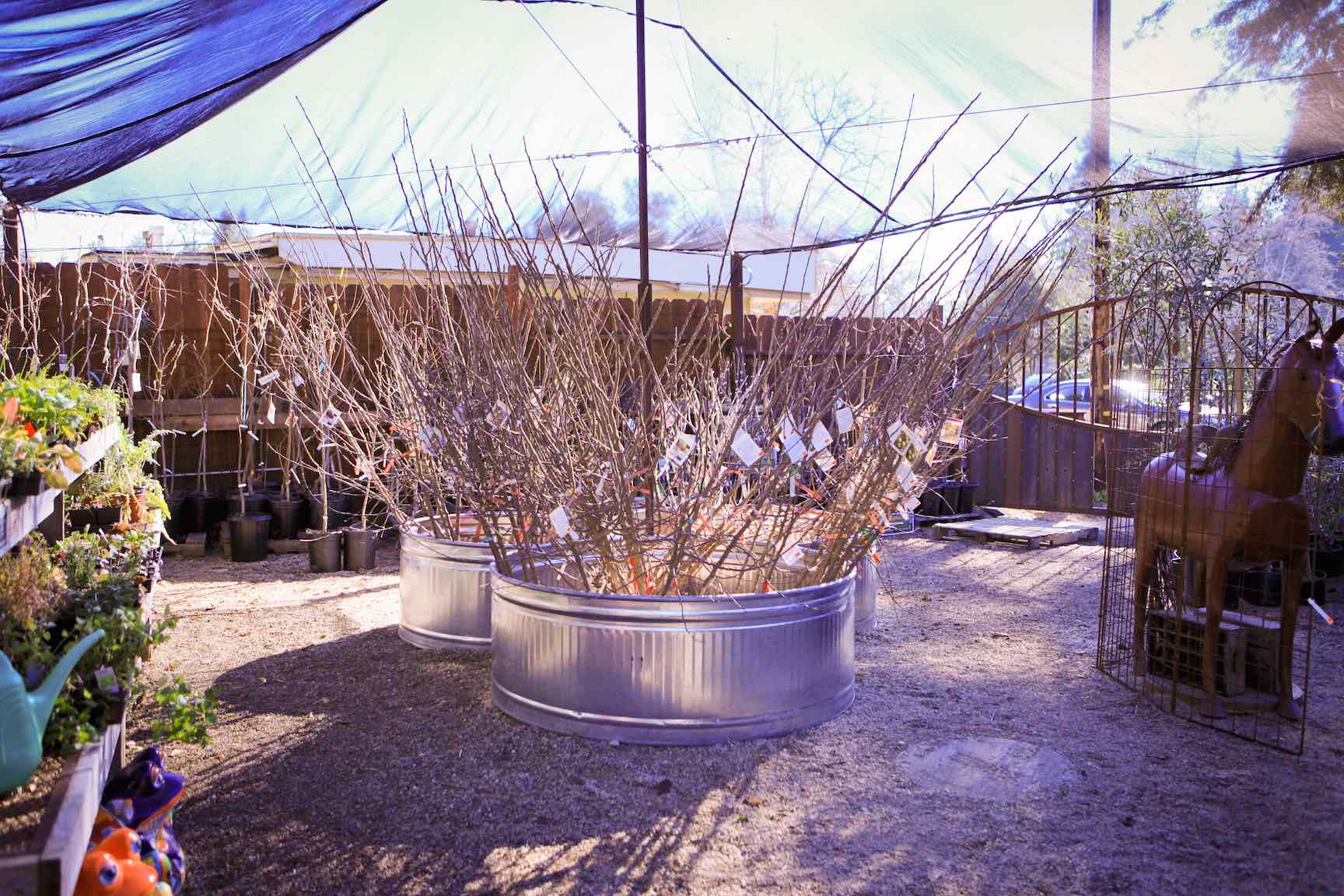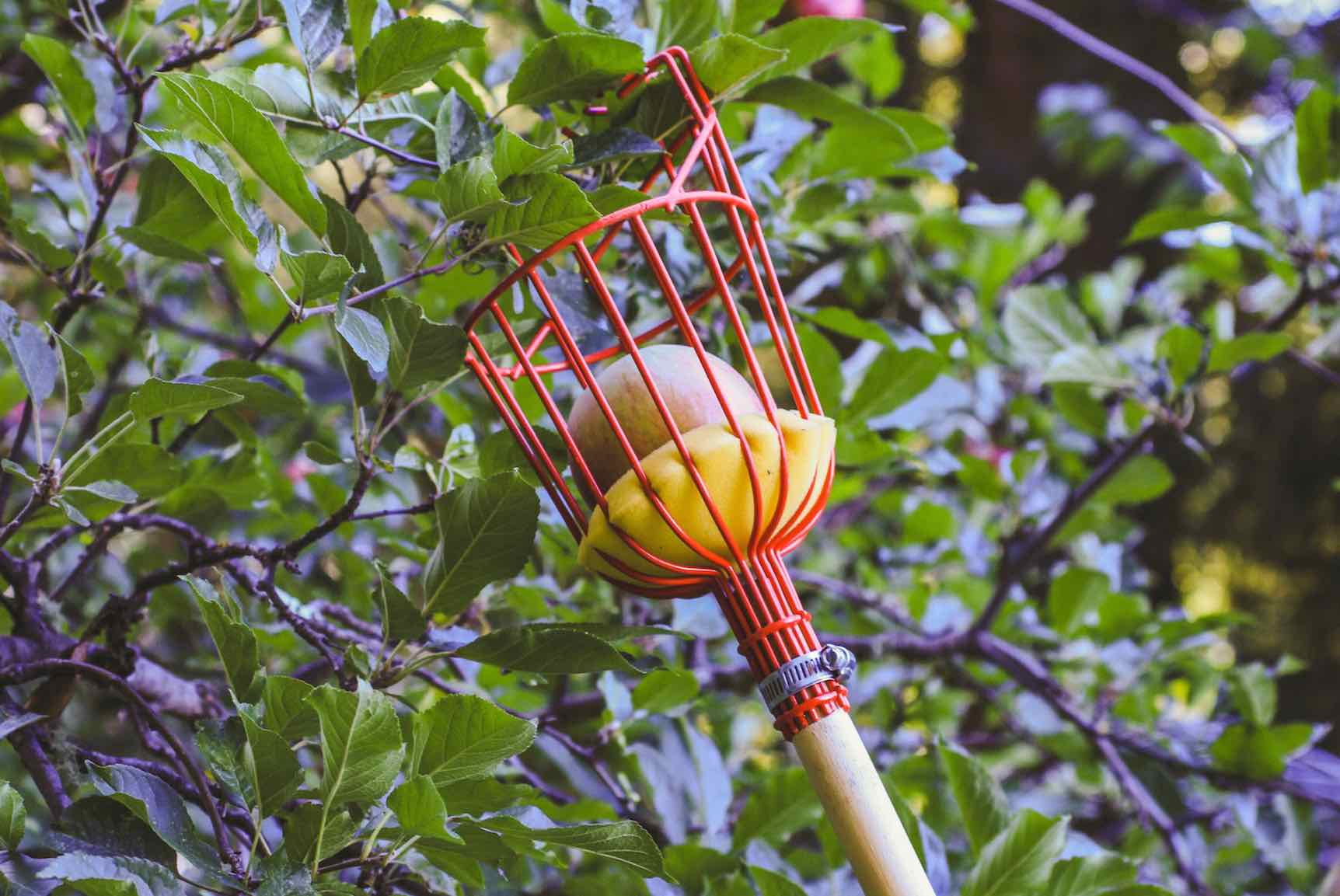- Continue Shopping
- Your Cart is Empty
Bare Root Fruit Trees: In-Depth FAQ

Bare brown branches, tangled roots, the subtle, tender swelling of bud and leaf nodes. Stored in damp sawdust, bareroot trees wait by the hundreds in our edible nursery, plain and unadorned even by the merest leaf or blossom. From afar, the nursery looks like a thicket in winter, all naked branch and trunk, waiting for the first flush of spring.
Beneath the bark, the trees are alive; asleep, you might say, or hibernating, waiting for the seasons to turn again. In the meantime, their potential is on display for all those who care to look for it. The shape of the root structure, the health of the graft union, the placement of branches; potential orchard keepers look at the trees with the future in mind.
They try, as in a game of botanical chess, to imagine into the future; how might this tree grow, how might I prune it? Which rootstock will best withstand a drought? Does this tree require a pollinator? Or perhaps their gaze is dreamier. What might this one look like from the kitchen window? I will pick apples with my daughter. This variety is good for pies and cider. My grandmother loved apricots...

Planting a fruit tree is an act of faith in the future. No matter what your considerations, the bare sapling, rarely over 6 feet high and thinner than a child’s arm, are beautiful more in light of their potential than their present form. It will take years before the crop can be properly called a harvest.
Folks will sometimes ask us. When is the best time to plant a fruit tree? Jorah answers this with a grin and says, ten years ago. But the second-best time is now. He says this no matter what the season, and it’s true; the sooner you get ‘em in the ground, the sooner they will begin bearing fruit.
But the bare-root season, right now, is the best time in terms of weather, availability, and selection.
The earth is damp, and rains are still falling, so the tree can begin to send out roots into welcoming soil. Since transplant shock can sometimes cause a tree to drop leaves or blossoms, it’s best to get the tree in the ground before this is a factor, ie while the tree is still bare. The selection is at its most varied right now, too, with a wide range of available varieties only seen at this time of year.

The trees, being dormant, are remarkably resilient to the stress of being uprooted and moved across the state. Their bare nature allows us a glimpse of the root structure that we rarely get to take into consideration when buying any other kind of plant. And without the camouflage of leaf and fruit and blossom to sway us, we can appraise the structure of the tree without distraction.
There’s plenty to consider when buying a fruit tree. Pruning considerations and chill hours, pollination and sunlight requirements, to name a few. So here’s a brief look at some of the factors that come into play. We leave the dreaming to you…
Bareroot Fruit Tree FAQ

Q: What are chill hours? How do I know how many for my area?
Chill hours refers to the number of hours in a growing season where the temperature sits between 32°F and 45°F. This is especially relevant to fruit trees, which require specific temperature ranges to successfully set fruit. A winter that is too warm for a specific variety (for example, an apple tree that requires 1300 chill hours in a warm El Nino year) will cause disruption to the tree’s "internal clock.”
Too few chill hours results in the tree breaking dormancy too late; it keeps “waiting” for those cold hours to signal that winter has indeed passed. In addition, the blossoms on a tree that has too few chill hours will tend to open sporadically rather than all at once, almost as if the tree is reluctant to believe that that is all the chill it’s going to get. This sporadic bloom further reduces the chances of pollination.
Too many chill hours, however, might damage the fruit set in other ways. As is the case with apple varieties like “Anna’s Apple”, which requires only 200-300 chill hours, it may break into bloom long before the rains are finished. Rain will damage the blossoms and lessen the chances of pollination by honeybees, which do not fly in the rain. In addition, excessive cold can damage tender trees like guavas, avocados and citrus.
Microclimates: Our area can be tricky, as there are so many microclimates, and the number of chill hours can vary widely, depending on what kind of winter we’re having. An El Nino year, which tends to be warmer, might yield 500-600 chill hours, while a colder year might give us as many as 800-1000 chill hours.
Folks up in Bonny Doon (higher elevation) tend to get colder in the winter than those down in Santa Cruz (sea-level). So the safest bet in our area is to choose trees that have around 500-800 chill hours. We tend to select varieties for sale that fall within this range, while recognizing that some intrepid gardeners may wish to push their luck for a particular variety which falls to either side of this safe range.
In addition, there are certainly some tricks that can be employed to increase chances for success with varieties that fall to the outside of the safe zone of your area's chill hours...
Planting in colder spots of the yard: Trees that require more chill hours should be planted to the lowest, ie coldest spot in the garden. It may even be beneficial to plant these trees where they will remain shaded and therefore colder for later in the year, as long as there is enough sun once they break dormancy.
Planting in warmer spots of the yard: Walls and fences, especially south facing ones, trap and radiate heat; planting near these will effectively decrease the chill hours, so this is a good area to put plants that like it a little warmer.
Q: How should I prune my bareroot fruit tree? What is the difference between summer and winter pruning?
There are many schools of thought and styles of fruit tree pruning, too many to go into great depth here. However, some general rules do apply...
Initial Pruning: When first planting a bareroot fruit tree, it is advisable to prune back the branches and central leader. The old rule of “as above, so below” is relevant here; a tree with fewer roots down below should be cut back up top, so as not to put too much stress on the undeveloped root system. Branches should be cut back to about half, paying attention to the direction that the nodes are facing; the growth continues in the direction that the node is pointing, and it’s best to aim the branches outward rather than inward. (In the first year of growth, it is inadvisable to let the tree produce fruit, as you want all of the tree’s energy going to healthy scaffold growth and root development. So this pruning is appropiate even for trees like persimmons, which fruit mainly on new shoots that originate from the tips of young branches, in the first year.)
Winter Pruning: Pruning in the winter has different effects than pruning in the summer. Also known as dormant pruning, it is done when the tree has no leaves and fruit to support. It allows the energy that the tree has stored up (in the form of carbohydrates) to be allocated to fewer growing points. It has an invigorating effect; cuts made in the winter will generally result in a pair of new shoots emerging just above the cut, when the tree begins to grow again. So when you make the cuts, picture how that will effect the next year's growth. As the tree grows, dormant pruning is done to influence fruit set and the overall structure of the tree.
A brief note on apricots and cherries here; these trees are often quite succeptible to infection from cuts that are made in wet weather; it’s best to delay the initial pruning for these, and prune them in summer if at all possible.
Summer Pruning: Summer pruning is done to control the overall height of the tree, and to thin out branches that may be shading the ripening fruit. The same cut, made in the summer rather than winter, will result in a different pattern of regrowth. Summer pruning forces growth lower down on the branches, not from the tips. Summer pruning can actually be done any time from mid-spring through fall. It has a deinvigorating effect on growth, which can be a good thing; sometimes we don’t want a lot of vigorous growth after a cutting. Save the big, stuctural cuts for winter pruning, but do any thinning or topping back in the summer.
Q: What does self-fruitful mean? Will the tree set fruit without a pollinator?
Every tree has different pollination requirements. Some set fruit all by themselves, while others need another tree of a different variety (but the same type) to pollinate them. The tag attached to the bare root stock gives basic information about the tree, and will give examples of trees that are pollinators for the tree in question.
For example, a Pink Lady® apple is self-fruitful, and needs no other apple trees nearby to set fruit (though fruit set may be increased in the presence of a pollinator.) Spitzenburg apples (one of my favorites, by the way) require a pollinator such as a Granny Smith or Gala nearby in order to set fruit. Really, what it requires is another apple that is blooming at the same time; some apples have earlier or later bloom times. If you have questions about whether or not a particular variety will pollinate another, ask us!
Q: What is a good choice for a fruit tree in a shady area?
Some trees definitely do better than others in cooler or partially shaded areas. Apples, pluots, and plums tend to be good choices for gardens that get some sun (at least 5 hours) every day, but are not considered full-sun. While full sun is ideal, these trees will still set and ripen some fruit in partially shaded conditions. Don’t bother with peaches, nectarines, or apricots, though; these fruits really love that hot sun to develop a sweet, tasty fruit. An apple ripened in less than ideal conditions will still be tasty; a peach with too little sun will just taste gross.
Q What is a grafted tree? Is it better to plant 4 single varities, or get a 4-in-1 multi-grafted tree?
That depends on the area you have to work with. Generally speaking, if you have the space, it is easier in the long run to have several separate trees.
All fruit trees are propagated through grafting; the fruit-bearing portions are grafted onto different rootstocks, which in turn are selected for qualities such as increased disease resistence or drought tolerance.
Multi-grafting refers to the technique of grafting multiple varieties onto a single rootstock. This can be done across a single species; ie a 3 in 1 cherry tree might have Bing, Ranier, and Stella cherries on the same tree. These varieties will have been selected to pollinate each other.
There are also “Fruit Salad" trees whose genetics are similar enough that you can get plums, pluots, peaches, and nectarines to grow on the same trunk. However, these trees require special attention when pruning. Generally, one branch or variety will tend to be more vigorous than the others. Some varieties grow slow, while others grow fast. In addition, some of the individual grafts may have “taken” better than others, and may be commandeering more resources from the tree than their fair share.
If careful attention is not paid at pruning time, the stronger graft(s) will quickly out compete the slower or weaker ones, leaving a lopsided tree, and possibly resulting in the death of one or several branches/varieties. However, for a garden with limited space, they are a wonderful way to get many varieties of fruit that there would not otherwise be room for.
Q How should I fertilize my bareroot fruit tree? What should I add when planting?
The tree is dormant when we plant it in bare-root season, and so it is taking up very little, if any, fertilizer. But adding a good balanced fertilizer can provide nutrients that will be available when the tree breaks dormancy.
Compost, added to the planting hole, will provide both nutrients and an improvement in soil texture.
Gopher Baskets: We also advise planting all fruit trees in gopher baskets; gophers love themselves a fruit tree. While the basket will not last forever, it will provide the tree with a head start, to hopefully get well rooted and established, and better able to withstand gopher damage in the future. The “tree-size” baskets are the best; even if the root ball will fit into a 5-gallon or smaller basket, the larger size will provide better protection against gophers. In addition, digging the larger hole to fit the basket will make it easier for the tree roots to expand into the soil.
Mixing compost and native soil: Mix both compost and native soil together when planting a tree. Using potting soil is not recommended, as it may cause the tree to preferentially send its roots only into the soft potting soil, and grow only in circles as though it were pot bound. You want those roots to extend outwards, in search of water and nutrients. Compost simultaneously helps the soil to retain moisture as well as increase drainage, so it’s good for both sandy and clay soils.
Mulch on top: Finally, a nice 1" layer of mulch or compost can do a lot to help keep roots cool and nourished. Be careful not to bury the graft; keep all mulch pulled back several inches from around the trunk of the tree.
We hope you gleaned some key bare-root insights from this FAQ. Don't hesitate to ask us all your questions by email, or come on down to the nursery and chat with one of our bare-root experts!

Over to You
It’s part of our mission here at Mountain Feed to help you make delicious, sustainable, homemade food more often. Stop by and say hello on Facebook, Twitter, Instagram or Pinterest. Or, as always, you can do it the old fashioned way and come by the store to speak with one of our in-house experts.
